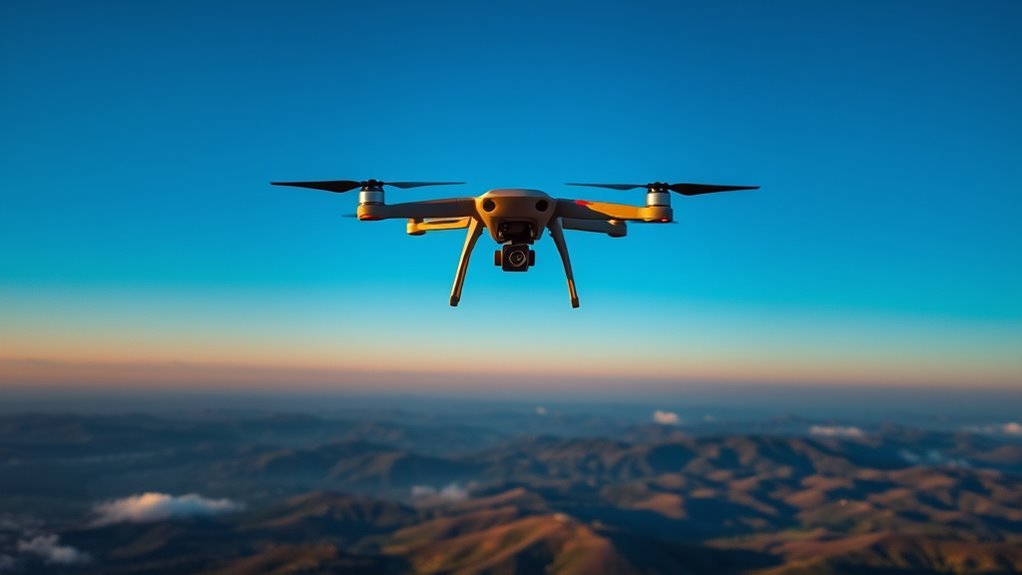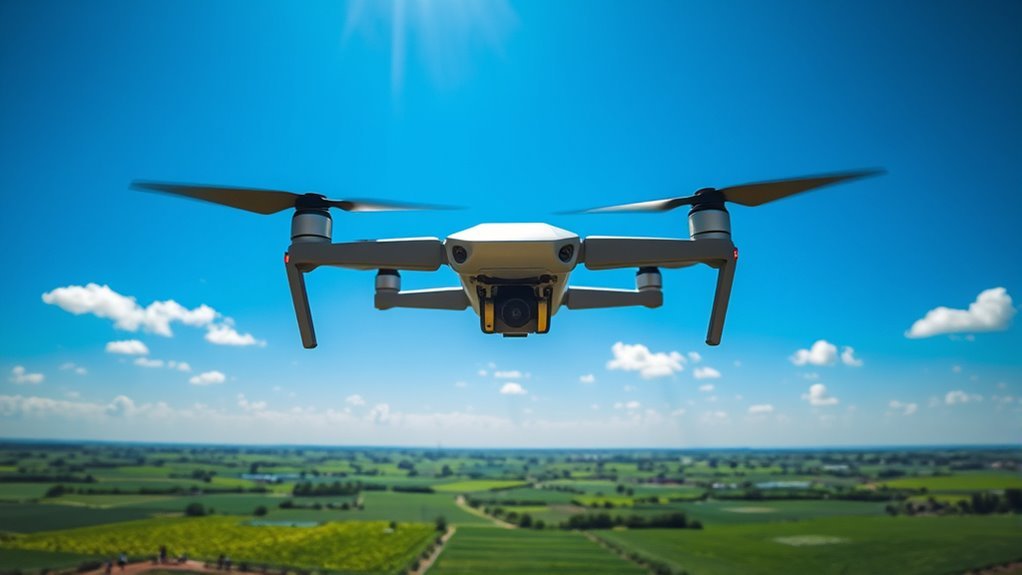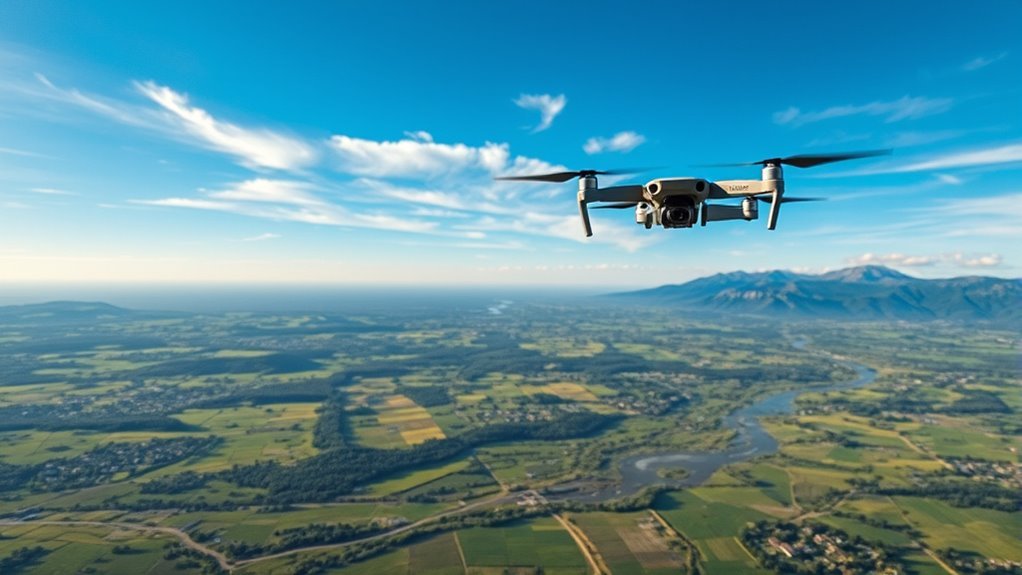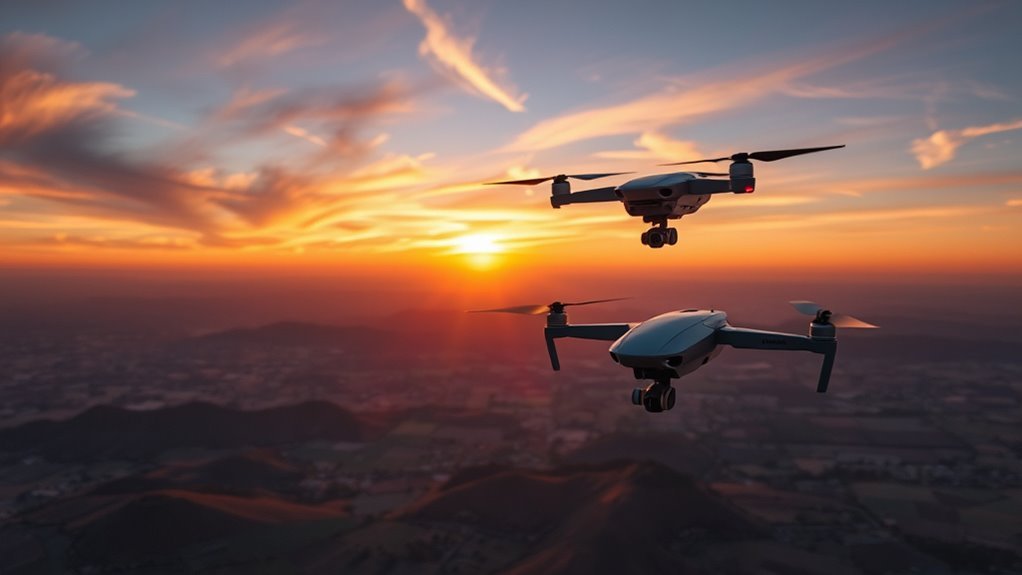Drones typically fly up to a maximum of 400 feet above ground level, adhering to strict regulations that guarantee safety and airspace integrity. Factors such as drone specifications, airspace classifications, and operational conditions can influence this altitude limit. Consumer models usually max out at this height, while professional drones equipped for specific purposes may have different capabilities. If you want to explore more about the intricacies of altitude regulations and future trends, there’s plenty more to uncover.
Understanding Drone Altitude Limits

While many enthusiasts are keen to explore the skies with their drones, understanding altitude limits is essential for compliance and safety. Drone technology has advanced considerably, enabling flights at impressive heights, yet regulations often cap these altitudes to maintain airspace integrity. Typically, you’re limited to a maximum altitude of 400 feet above ground level. This restriction isn’t just bureaucratic; it helps mitigate altitude challenges that could arise from nearby manned aircraft. Signal strength can also be affected at higher altitudes, which may complicate communication with your drone. Maneuvering these limits can enhance your flying experience, allowing for creative exploration while ensuring you operate within legal boundaries. Familiarizing yourself with altitude regulations will not only keep you compliant but also empower you to maximize your drone’s potential without jeopardizing safety or freedom. Additionally, high altitudes can lead to challenges such as atmospheric absorption that may weaken radar signals and complicate detection efforts.
Factors Influencing Maximum Flight Height

When considering how high a drone can fly, both regulatory restrictions and drone specifications play vital roles. You’ll need to navigate airspace regulations that often impose strict altitude limits. Additionally, the design and capabilities of your drone will determine its maximum operational height.
Regulatory Restrictions
As you explore the capabilities of drones, it’s essential to contemplate the regulatory restrictions that govern their maximum flight height. Regulatory compliance is vital, as various laws dictate altitude enforcement based on airspace classifications. Understanding these rules can help you maximize your drone’s potential while avoiding legal pitfalls.
| Airspace Class | Maximum Altitude (feet) |
|---|---|
| Class G | 400 |
| Class E | 1,200 |
| Class C | 4,000 |
| Class B | 10,000 |
| Class A | Above 18,000 |
Navigating these restrictions can enhance your operational freedom, ensuring your drone remains within safe and legal boundaries while you explore the skies.
Drone Specifications
Drone specifications play an essential role in determining maximum flight height, influenced by various technical factors. Understanding these specifications can help you choose the right drone type for your needs and desired altitude. Here are three key aspects that affect flight height:
- Motor Power: The strength of the motors dictates how much lift the drone can generate, directly impacting its altitude capabilities.
- Weight and Payload: Heavier drones require more power to ascend, limiting their maximum altitude. Consider the weight of additional equipment.
- Altitude Sensors: These devices help maintain stable flight at various heights. High-quality sensors can enhance a drone’s ability to reach and maintain significant altitudes.
Legal Regulations Governing Drone Altitude

When operating a drone, you must understand the legal altitude limits set by regulatory authorities. These limits vary based on airspace classifications, which dictate where and how high you can fly. Familiarizing yourself with these regulations is essential for ensuring compliance and safe operation.
Maximum Altitude Limits
Pilots must adhere to specific maximum altitude limits set by legal regulations to confirm safe and responsible drone operation. These limits guarantee that drone technology is used within a framework that prioritizes safety and compliance. Here are three key altitude restrictions you should know:
- 400 feet AGL: Typically, drones can’t exceed this altitude unless you’re flying within controlled airspace with permission.
- Special Use Airspace: Certain areas may have lower altitude limits, especially near airports or military zones.
- Altitude Testing Regulations: For experimental purposes, altitude testing may require additional permissions from aviation authorities.
Understanding these limitations helps maintain a balance between freedom and safety, allowing you to enjoy the full potential of your drone while adhering to necessary regulations.
Airspace Classifications Explained
Understanding airspace classifications is essential for safe drone operation, as different categories dictate where and how high you can fly. In the U.S., airspace is divided into several classes: A, B, C, D, E, and G. Each class has specific rules affecting altitude safety and airspace navigation. For instance, Class B airspace surrounds major airports and requires specific clearances, limiting your drone’s operational altitude. Conversely, Class G airspace is uncontrolled, allowing for more freedom but still demanding awareness of other air traffic. Familiarizing yourself with these classifications guarantees compliance with regulations while maximizing your drone’s potential. Always prioritize altitude safety to prevent accidents and legal issues, enabling you to enjoy the freedom of flight responsibly.
Consumer Drones vs. Professional Models
While both consumer drones and professional models serve distinct purposes, their design and capabilities reflect the varying needs of their users. Understanding these differences can help you choose the right type for your needs.
- Consumer Drone Features: Typically lightweight, user-friendly, and equipped with basic cameras, these drones are designed for recreational use and simple photography.
- Professional Drone Capabilities: These models often include advanced imaging technology, extended flight times, and robust GPS systems, catering to industries like filmmaking, surveying, and agriculture. For example, the DJI Mavic 3 Pro is known for its impressive camera system and exceptional flight stability, making it a top choice for professionals.
- Regulatory Compliance: Professional drones may adhere to stricter regulations, ensuring safety and reliability for commercial applications.
Recognizing these contrasting attributes empowers you to make informed decisions, optimizing your drone experience.
Record-Breaking Drone Flights
How high can drones really fly? Record-breaking drone flights have pushed the boundaries of altitude challenges, showcasing the incredible capabilities of modern technology. Some drones have reached altitudes exceeding 30,000 feet, a feat achieved through advanced engineering and optimized aerodynamics. These impressive heights aren’t just for show; they provide valuable data for atmospheric research, environmental monitoring, and telecommunications. The race for higher altitudes continues, with engineers constantly innovating to overcome limitations like battery life and structural integrity. As you explore the potential of drones, consider how these achievements redefine our understanding of airspace and the freedom it offers. In this evolving landscape, the sky isn’t the limit; it’s just the beginning of what’s possible.
Safety Considerations for High Altitude Flights
Achieving impressive altitudes with drones comes with a set of safety considerations that operators must prioritize. High-altitude flights require meticulous planning to mitigate risks and guarantee compliance with regulations. Here are three key considerations:
Achieving high altitudes with drones demands careful planning and a focus on safety to ensure compliance and mitigate risks.
- Risk Assessment: Before launching, evaluate potential hazards, including weather conditions and airspace restrictions. Understanding these factors is vital for safe operations.
- Emergency Protocols: Develop and familiarize yourself with emergency procedures, such as loss of signal or battery failure. Quick reactions can prevent accidents and protect your equipment.
- Communication: Maintain clear communication with air traffic control or local authorities, especially when operating in shared airspace. This helps coordinate safe flights and avoid conflicts. Additionally, be aware of the frequency bands being used in your area, as they can impact signal quality and operational safety.
Future Trends in Drone Flight Capabilities
As technology continues to evolve, the future of drone flight capabilities looks promising, with advancements poised to expand operational limits and enhance efficiency. You’re likely to see significant improvements in autonomous flight systems, enabling drones to navigate complex environments without human intervention. This autonomy will be underpinned by sophisticated algorithms and AI, allowing for real-time decision-making. Moreover, altitude technology is advancing, which means drones could soon operate at previously unreachable heights, optimizing range and payload capacity. These innovations not only enhance logistics and surveillance capabilities but also empower a new era of freedom in drone usage, making them indispensable tools across various sectors, from agriculture to emergency response. The potential is limitless as these technologies converge, especially with real-time data processing that allows for instantaneous analysis and decision-making during operations. Additionally, advancements in precision insights will facilitate tailored applications for agricultural drones, enhancing crop management and resource efficiency.
Frequently Asked Questions
Can Drones Fly Higher Than Manned Aircraft?
Imagine a drone soaring above a mountain range, yet it must comply with drone regulations that impose altitude limits. While some drones can reach impressive heights, manned aircraft typically operate at higher altitudes, ensuring safety.
What Is the Highest Altitude a Drone Has Ever Reached?
The highest altitude a drone has achieved involves record-breaking flights, often exceeding 80,000 feet. While many drones face altitude limitations due to regulations and technology, advancements continue to push these boundaries, expanding your flying possibilities.
How Does Weather Affect Drone Altitude Capabilities?
Weather conditions can greatly impact your drone’s altitude performance; strong winds can limit stability, heavy rain can reduce visibility, and temperature variations can affect battery efficiency. Understanding these factors is essential for safe and effective flying.
Can Drone Altitude Be Modified or Adjusted?
Yes, you can modify drone altitude limits through the settings. By adjusting these parameters, you’re able to customize your drone’s performance, ensuring it achieves the desired altitude while adhering to local regulations and safety guidelines.
What Are the Best Drones for High-Altitude Flying?
For high-altitude flying, you’ll want drones with robust specifications, like powerful batteries and advanced stabilization systems. Look for models featuring high altitude capabilities to guarantee stable performance and freedom in diverse aerial environments.

